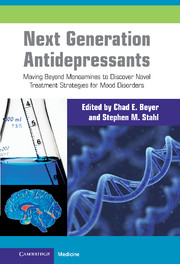 Next Generation Antidepressants
Next Generation Antidepressants Book contents
- Next Generation Antidepressants
- Next Generation Antidepressants
- Copyright page
- Contents
- Contributors
- Preface
- Abbreviations
- Chapter 1 Current depression landscape
- Chapter 2 Novel therapeutic targets for treating affective disorders
- Chapter 3 Developing novel animal models of depression
- Chapter 4 Translational research in mood disorders
- Chapter 5 Defining depression endophenotypes
- Chapter 6 Genetic and genomic studies of major depressive disorder
- Chapter 7 Medicinal chemistry challenges in the design of next generation antidepressants
- Chapter 8 Application of pharmacogenomics and personalized medicine for the care of depression
- Index
- References
Chapter 4 - Translational research in mood disorders
using imaging technologies in biomarker research
Published online by Cambridge University Press: 19 October 2021
- Next Generation Antidepressants
- Next Generation Antidepressants
- Copyright page
- Contents
- Contributors
- Preface
- Abbreviations
- Chapter 1 Current depression landscape
- Chapter 2 Novel therapeutic targets for treating affective disorders
- Chapter 3 Developing novel animal models of depression
- Chapter 4 Translational research in mood disorders
- Chapter 5 Defining depression endophenotypes
- Chapter 6 Genetic and genomic studies of major depressive disorder
- Chapter 7 Medicinal chemistry challenges in the design of next generation antidepressants
- Chapter 8 Application of pharmacogenomics and personalized medicine for the care of depression
- Index
- References
Summary
Dramatic scientific and technological advances in the field of drug discovery have been made over the past decade, without a corresponding improvement in the success rate of compounds in clinical development. In response, translational research was developed as a research discipline with the aim of improving the correspondence between preclinical and clinical success of therapeutic treatments by identifying novel disease biomarkers, drug targets, and mechanisms of action for compounds of interest. Functional magnetic resonance imaging (fMRI) and positron emission tomography (PET) have been widely used to reveal the neurobiological underpinnings of human cognition and emotion. The knowledge gained from such studies is currently being employed in the clinical setting to better diagnose and develop treatments for mood disorders. Many of the imaging techniques established in humans are now feasible in animal models (rodents and non-human primates), allowing closer alignment of imaging biomarkers across species and improved congruency between the laboratory and clinical setting. In this review, we explore the use of neuroimaging biomarkers as a translational technique to pave the way to improved clinical success through greater psychiatric disease understanding.
- Type
- Chapter
- Information
- Next Generation AntidepressantsMoving Beyond Monoamines to Discover Novel Treatment Strategies for Mood Disorders, pp. 45 - 69Publisher: Cambridge University PressPrint publication year: 2010
